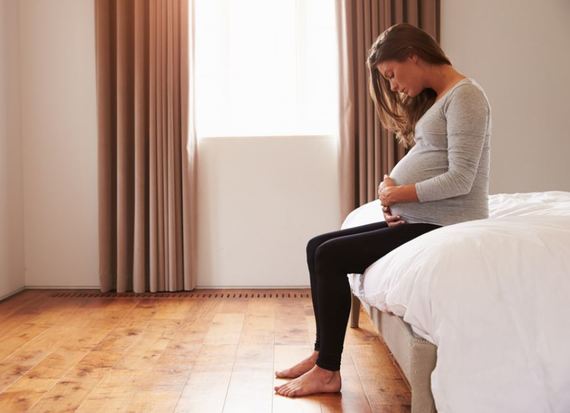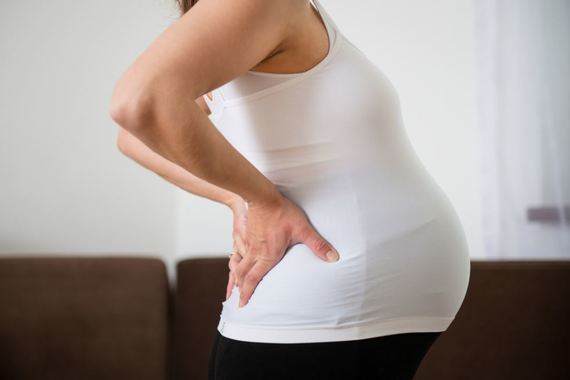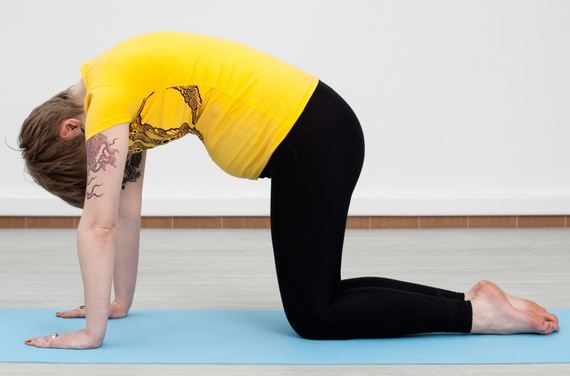Due date approaching? These exercises will HELP you prepare for labour
Filed under:
MummyBloggers

True to its name, labour is tough. Like running a marathon tough. And just like training for a race you need to prepare your body for giving birth, properly.
From keeping your pelvic floor muscles strong to stretching your back, the following five exercises will help you.
1. Kegels
Kegel exercises work the pelvic floor muscles that support your pelvic organs - the vagina, urethra, cervix, uterus, bladder, small intestines, and rectum. Strengthening your pelvic floor muscles provides better support for these organs and can help prevent or treat urinary stress inconsistency.
There's even some evidence to suggest that having good control of your pelvic floor muscles may help during the pushing stage of laybor. The theory is that if you can voluntarily relax those muscles, you can make it easier for your baby to be born.
First, "find" your pelvic floor muscles: Can you tighten the muscles around your vagina and interrupt the flow of urine when going to the bathroom? If so, you've located your pelvic floor muscles and just performed a kegel exercise. Practice several times while urinating to get comfortable activating that muscle group.

Once you know how to isolate and control your pelvic floor muscles, try practicing long, slow contractions: increase the contraction strength for a count of five seconds, hold for another five, then relax slowly for a count of five.
Think of the pelvic floor as an elevator that is moving up a floor for each count of five, and going down as you relax for a count of five. Work up
to 10 or 15 long, slow contractions twice a day.
You can also perform "quick flicks": This exercise strengthens a different type of muscle fibre in the pelvic floor. Contract the muscles quickly by squeezing for two to three second pulses, for 10 to 20 repetitions. Work up to 40 to 60 quick flick contractions twice a day.
Your buttocks, hips, and thighs shouldn't move when you do these exercises, so if you're having trouble isolating the right muscles, ask your healthcare provider for advice.
2. Squat
It may not be the most elegant position, but squatting is a time-tested way of preparing for and giving birth. This exercise strengthens your thighs and helps open your pelvis.
- Stand facing the back of a chair, with your feet slightly more than hip-width apart and your toes pointed outward. Hold the back of the chair for support.
- Contract your abdominal muscles, lift your chest, and relax your shoulders.
- Then lower your tailbone toward the floor as though you were sitting down on a chair. Find your balance – most of your weight should be toward your heels. Hold this position for as long as it's comfortable.
- Take a deep breath in and then exhale, pushing into your legs to rise to a standing position.

3. Back stretch
This exercise stretches the muscles along your spine and shoulders as well as the back of your legs. Try this stretch whenever you feel tension in your back. It can also help relieve muscle tightness during labor.
- Facing a wall, bend forward from the hips until your legs and upper body form a 90-degree angle. Your back should be flat, and your legs straight or slightly bent.
- Place your hands against the wall at shoulder level. Allow your head to relax and stay level with your arms as you face down, looking at the floor.
- Press your hands into the wall as you lean backward from your hips until you feel a stretch in your back and in the back of your legs.
- Hold for five to 10 seconds, then relax and return your hips to the previous position.
- Repeat two to three times.

4. Pelvic tilt
This is done on all fours, strengthens the abdominal muscles and eases back pain during pregnancy and labor.
- Get down on your hands and knees, with your arms shoulder-width apart and your knees hip-width apart. Keep your arms straight, but don't lock your elbows.
- As you breathe in, tighten your abdominal muscles, tuck your buttocks under, and round your back.
- Relax your back into a neutral position as you breathe out.
- Repeat at your own pace, following the rhythm of your breath: Count to five as you slowly arch your back and tuck your pelvis under, and count to five as you slowly return to the neutral position.
- Repeat three to five times.

5. Exercise ball
Exercising on a ball in pregnancy can help to reduce any back pain you are experiencing and make it easier for you to move around. It can also help ease labour pain, reduce the pain of contractions (especially if you use it for a couple of months before you give birth), decrease anxiety and shorten the first stage of labour. However if you feel dizzy or ill, donʼt use your ball.
Your height will give a guide to the size of ball that will be right for you. Ideally, your knees should be about 10cm (4in) lower than your hips when you sit on it.
As a general rule:
- If you're up to 1.73m (5ft 8in) in height, it's best to get a 65cm ball.
- If you're 1.75m (5ft 9in) or taller then it's best to get a 75cm ball.
A birthing ball will take your weight, whatever your size. Good quality birthing and gym balls are pressure-tested to support weights up to 300kg (about
47st).
Try:
- Sitting on the ball and rocking your pelvis from side to side and front to back. When you do this, try to keep your shoulders still so the movement comes from your waist and below.
- Rotating your hips clockwise then anti-clockwise.
- Leaning over your ball from a kneeling position, then rocking your hips forward and back.

Help change the position of your baby in late pregnancy:
- If your baby is in a posterior (back to back) position, adopting upright, forward-leaning positions may encourage him to switch around.
- Try getting on to your knees and leaning forward over your ball. This may encourage your baby's back to swing forward so he's in an anterior position, with his back towards your bump. Although your baby may not stay that way until you go into labor, it may give you some temporary relief from backache.
Ways to use your birth ball during labour include:
- Sitting astride the ball and rocking your pelvis from side to side or back and forth.
- Leaning on your birthing ball from a kneeling position on the floor.
- Getting into a hands-and-knees position by hugging your birthing ball and lifting your bottom up from a kneeling position. You can then rock your
- pelvis from side to side.
- Leaning over your ball from a standing position, with the ball on the bed or another surface.
These positions also give your birth partner plenty of room to support you, massage you or apply pressure to your lower back during contractions.
During the pushing stage you'll want to avoid sitting, so use the leaning or hands-and-knees positions. They will take the pressure off your bottom and give your baby lots of room to descend with each contraction and to be born.
Evee Parroche is a personal trainer with 13 years experience. She is Mum to a one-year-old and is also pregnant with her second child. She blogs at Fit Bumps and Mums, where she provides top tips for a fit and healthy pregnancy, and also healthy ways to get back into shape after having your baby.

















